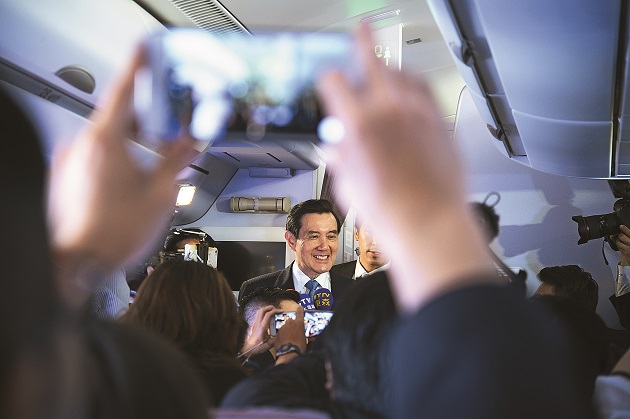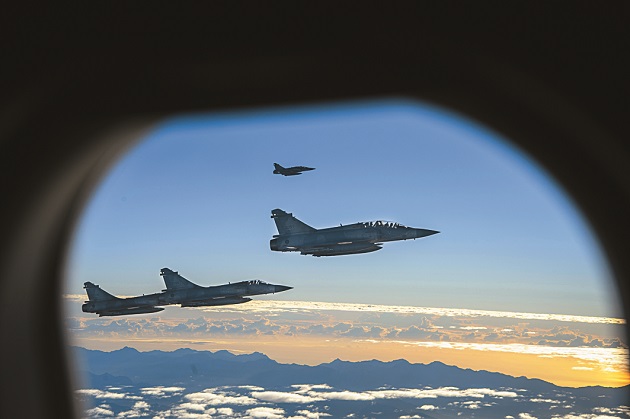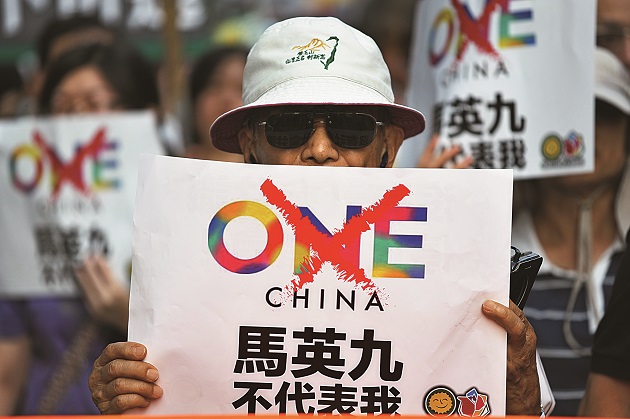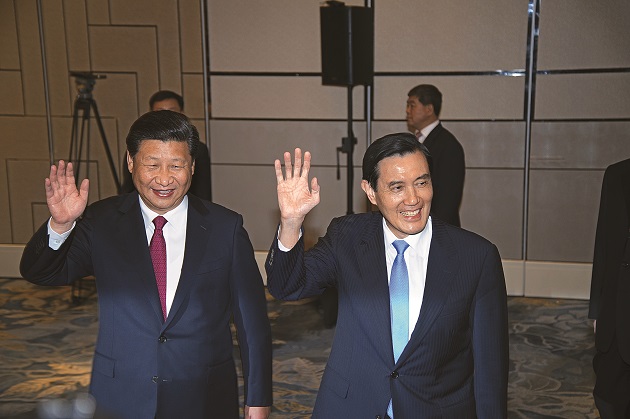The Ma-Xi Meeting
Political Theater or Meaningful Moment?

Source:CW
The presidents of the Republic of China (Taiwan) and the People’s Republic of China met for the first time ever in Singapore on Nov. 7. Did it set a valuable precedent for cross-Taiwan Strait relations, or was it merely a blip in the radar that will soon give way to less harmonious times?
Views
Political Theater or Meaningful Moment?
By Ming-hsien Lee, Yi-shan Chen, Kuo-chen LuFrom CommonWealth Magazine (vol. 585 )
In August 1945, Mao Zedong came out of his mountain lair in Yan’an to take the first flight of his life, a trip south to muggy Chongqing, the wartime capital of the Republic of China and headquarters of Chiang Kai-shek’s Kuomintang (KMT). It was the last meeting between the leaders of the rival KMT and Chinese Communist Party (CCP).
At the time, Chiang was the chairman of the Nationalist government’s National Military Council and Mao was the chairman of the Communist Party. Four years later, Mao founded the People’s Republic of China while Chiang was forced to retreat to Taiwan.
Fast forward 70 years to Nov. 7, 2015, 3 p.m. Ma Ying-jeou, president of the Republic of China (Taiwan), and Xi Jinping, president of the People’s Republic of China, walked almost furtively into a big hall at the Shangri-La Hotel in Singapore, shook hands and turned toward the media throng in attendance. No master of ceremonies, no addressing each other, no sharing of pleasantries. The scene was a historic milestone in relations between Taiwan and China, hostile rivals since the end of the Chinese civil war 66 years ago.
“The most amazing sight was the thousand hands raised high, pointing cameras and smartphones at Ma and Xi, as though worshipping the two leaders,” said one of CommonWealth Magazine’s reporters covering the event.
A thousand flashes went off simultaneously, creating a shine from a seemingly radiant sun. Many reporters later discovered that the pictures they took appeared overexposed, bathed in a shiny bright film.
The huge number of flashes illuminated the shadows of Ma and Xi against a vibrant yellow background, shadows that will linger after the meeting and its emphasis on the “1992 consensus” as the new round of challenges to Taiwan’s fate take center stage.
The Meeting an Achievement Itself
“It appears that the meeting itself will be the event’s principal achievement. After 65 years of relations that were ambivalent at best and downright dangerous at worst, a Ma-Xi meeting would affirm the changes for the better that have occurred since Ma came to power and suggest a promise of more to come,” said Richard Bush, the director of the Center for East Asia Policy Studies at the Brookings Institution and a former chairman of the American Institute in Taiwan, two days before the meeting.
Billing the Ma-Xi meeting as the beginning of a new era in the context of history would be premature, but it declared that the Cold War era following World War II had come to a complete end.
Philip Yang, the president of the Association of International Relations and a former member of the National Security Council, says the Korean Peninsula, the South China Sea and the Taiwan Strait have been the major hotspots in East Asia since the break-up of the Soviet Union and the conclusion of the Cold War. The national leaders of North and South Korea have met, so a meeting between the two leaders was a long time in coming.
To Ma and Xi, the event also seemed to be about their historical legacy. In an interview with CommonWealth Magazine, Taiwanese poet and social observer Wu Sheng criticized Taiwan’s president for rushing to meet with China’s leader just two months before a new president is to be elected on Jan. 16, 2016. He argued that Ma did it simply for the sake of his personal legacy – to be the first president of the Republic of China to break the ice since the split between the two sides of the Taiwan Strait.
Chang Wu-ueh, a professor in Tamkang University’s Graduate Institute of China Studies, says that to every generation of Chinese leaders, their Taiwan policy represents an important indicator of their political legitimacy and historical legacy. Mao Zedong had “peaceful liberation,” Deng Xiaoping proposed “one country, two systems,” Jiang Zemin had an “eight-point formula” for resuming dialogue with Taiwan, and Hu Jintao broached a “six-point proposal.”
Xi’s decision to meet with Ma transcended all of those positions, because he scored a breakthrough none of the others achieved.
Display of Power vs. Morale Boost
“My first impression was that Xi Jinping’s position is really stable,” said one member of Taiwan’s art community of the meeting. “In daring to take this breakthrough step, he showed he has neutralized the many different power factions within the Communist Party.”
A Beijing correspondent of Japanese business daily the Sankei Shimbun, Akio Yaita, disagreed. He said that Xi has little to show for his domestic agenda other than the anti-corruption campaign, and he needed an eye-catching event to boost political morale and elevate his personal image inside the party and the country and overseas.
 President Ma Ying-jeou seemed to be in a good mood when meeting with reporters on his presidential plane on the way home from Singapore.
President Ma Ying-jeou seemed to be in a good mood when meeting with reporters on his presidential plane on the way home from Singapore.
Shi Yinhong, an international relations professor at Renmin University and advisor to China’s State Council, said Beijing figured that if the opposition Democratic Progressive Party is voted into power in January 2016 as polls suggest, there would be no guarantee the KMT could return to power in four or eight years or even further into the future, making a meeting between the two sides’ leaders unlikely in the foreseeable future. It was either now or never.
When the meeting was first announced on Nov. 4, it was made clear that no agreements would be signed, no joint statement would be issued, and the two sides would hold separate press conferences, giving them wiggle room to state their own positions. Yet despite these parameters, many in Taiwan quickly harbored unrealistic expectations or fears.
After news of the meeting emerged on Nov. 4, Taiwan’s stock market rose sharply, and Darson Chiu, an associate research fellow at the Taiwan Institute of Economic Research, suggested how helpful it would be if Xi publicly pledged support for Taiwan’s bids to two trade blocs – the Trans-Pacific Partnership and yet to be concluded Regional Comprehensive Economic Partership.
DPP presidential candidate Tsai Ing-wen described the meeting as an “ambush,” because of the possibility that benefits offered by China could help the KMT reverse its dim election prospects, as the DPP argues occurred in 2012, when Ma won re-election against Tsai by 6 percentage points.
Philip Yang summed it up beforehand: “The key to success or failure of the Ma-Xi meeting will be what Zhang Zhijun says on Xi Jinping’s behalf at the (post-meeting) press conference on Nov. 7.
Minimal Gains
When Zhang showed his cards on Nov. 7, those who had expected China to offer concessions saw their dreams dashed.
In the closed-door meeting with Xi that lasted just under one hour, President Ma raised several issues of interest to Taiwan – completing negotiations on a cross-strait trade-in-goods agreement; establishing representative offices in each other’s territory; allowing Chinese travelers to transit in Taiwan; setting up a hotline connecting Taiwan’s Mainland Affairs Council and China’s Taiwan Affairs Office; having Chinese students study in Taiwan; and participating in regional economic integration.
 Soon after taking off, President Ma Ying-jeou's presidential plane was escorted by Taiwan Air Force Mirage-2000 jet fighters.
Soon after taking off, President Ma Ying-jeou's presidential plane was escorted by Taiwan Air Force Mirage-2000 jet fighters.
But during Zhang’s press conference, China only agreed to the hotline idea and pledged to step up talks on a merchandise trade deal and setting up reciprocal representative offices.
On the issue of PRC nationals transiting through Taiwan to third countries, Zhang said nothing. It was the benefit Taiwan most wanted because the restriction puts its airlines at a disadvantage, unable to offer their favorable connections to the U.S., Southeast Asia and Australia to the big market of Chinese travelers.
On Taiwan joining the Asian Infrastructure Investment Bank (AIIB), Zhang said it could do so but only in “an appropriate way.” On Taiwan’s international presence, Zhang said reasonable arrangements could be made but only if they did not create “two Chinas” or “one China, one Taiwan” and were negotiated through pragmatic consultations. In other words, China is still calling the shots.
“At best, it met our basic expectations,” said one government official privately.
To Shi Yinhong, the only concrete development was that “China agreed to Taiwan entering the AIIB using an appropriate method.”
It was a pledge that Beijing had actually made in the past before rejecting, in April 2015, Taiwan’s application to be an AIIB founding member, reportedly because of differences over the name Taiwan used in its application.
If progress is made quickly, Taiwan could join the bank before the country’s next president takes office on May 20, 2016. But if progress is slow, and the DPP’s Tsai wins office as expected and does not accept the designation “Chinese Taipei” to join the bank, then Taiwan’s bid will falter.
Shi explains that Xi’s discourse on cross-strait relations is an extension of the framework for peace across the Taiwan Strait proposed by Xi’s predecessor Hu Jintao in 2007.
Through Zhang’s press conference, Xi Jinping warned the DPP that the “1992 consensus” was his bottom line, that Taiwan independence was the main threat perceived by China and that key choices needed to be made on the direction of cross-strait ties.
“His attitude toward the DPP was unyielding. He told the DPP: Mr. Ma and the mainland have paved a fundamental path, which is the ‘1992 consensus.’ Follow it, and good things will happen. Don’t, and there won’t be good relations with you even if you try walking a fine line,” Shi said.
Richard Bush, in a post on the meeting on Nov. 9, foresaw the potential for “a serious stand-off” if the DPP’s Tsai takes power next year, based on the statements made by Xi and Ma at the meeting and Tsai’s reaction to it.
“There is some overlap in these three statements. Xi and Ma agree on the importance of the 1992 consensus, and Ma and Tsai agree that the Taiwan public should and does have a say on cross-Strait policy. Xi and Tsai, however, agree on nothing,” he wrote.
Hitting a Raw Nerve
The “1992 consensus” as generally stated refers to a formula under which Taipei and Beijing agree that there is only “one China,” with the two sides free to interpret what that “one China” means.
It has been the foundation of Ma’s China policy since he took office in May 2008, but the DPP has never recognized its existence, a problem for Beijing since it will likely have to deal with a DPP administration beginning next year.
 On the day of the Ma-Xi meeting, protesters in Taipei rallied agianst the "one china" princilple expressed in the "1992 consensus" that figured so prominently at the meeting.
On the day of the Ma-Xi meeting, protesters in Taipei rallied agianst the "one china" princilple expressed in the "1992 consensus" that figured so prominently at the meeting.
It was no surprise then that the Ma-Xi meeting touched the Taiwan’s raw unification-independence nerve, prompting a new round of criticism against the already unpopular president.
After the meeting, Tsai read a harshly worded statement: “It is with regret that we see the only result from the Ma-Xi meeting was their attempt to limit the people’s ability to choose the future of cross-strait relations by setting political preconditions on the international stage.”
On the day of the encounter, a parade was organized under the theme “stop trade-in-goods negotiations, protest the Ma-Xi meeting.”
Miao Po-ya, a 28-year-old who is running for a seat in the legislative elections that will coincide with the presidential election on Jan. 16, was angered when Ma described the “1992 consensus” in his opening remarks made in public as “a consensus reached by the two sides of the Taiwan Strait based on the ‘one China’ principle.”
“How will the international community look at Taiwan in the future? Even our own president said he recognized ‘one China,’” Miao complained.
Tao Yi-feng, a political science professor at National Taiwan University, voiced a similar criticism. “Ma Ying-jeou said at the international press conference that he opposed “two Chinas,” “one China, one Taiwan” and “Taiwan independence,” in essence vetoing Taiwan’s future options. Is this something the president of the Republic of China should say?”
Noting that young people reacted negatively online to Ma’s performance, Tao believes that because Xi did not offer the KMT any concessions, focusing only on reiterating the “1992 consensus,” the meeting will only hurt the KMT’s election prospects.
In fact, the only “gift” Xi gave the KMT was the “1992 consensus” intimidation card, but it remains to be seen if the KMT will use it in the final two months of campaigning.
A survey on political attitudes in Taiwan conducted annually over the past 24 years by National Chengchi University’s Election Study Center shows that siding with China could backfire in a national election.
The survey asks people how they identify themselves, as “Taiwanese,” “Taiwanese and Chinese,” or “Chinese,” or “no position.” The number of respondents identifying themselves as Taiwanese exceeded 50 percent for the first time in 2009, and it has continued to rise since, reaching 60 percent in 2015, about twice as high as the percentage of those saying they are “Taiwanese and Chinese.” Only 3.5 percent identified themselves as “Chinese.”
Is the ‘1992 Consensus’ a Straitjacket?
Could the “1992 consensus” become a straitjacket constricting Taiwan? How will the new president consolidate a consensus within Taiwan, preserve cross-strait peace and create openings for participation in the international community?
Chu Yun-han, an Academia Sinica academician and political science specialist, is not pessimistic. He compared the “1992 consensus” to a trusted pole used by a pole vaulter time and again for more than 20 years to enable cross-strait ties to rise to unprecedented heights.
When Tsai Ing-wen headed the Mainland Affairs Council, she opened the mini-three links (limited postal, transportation and trade links between the Taiwan-held Kinmen and Matsu islands and Chinese cities in Fujian province) under the “1992 consensus,” Chu says, saying the key to the “1992 consensus” is how you use it.
In addition, because Ma is no longer the chairman of the KMT, the Ma-Xi meeting broke through the model that had been set since 2005 of KMT-CCP interaction. This has set a new precedent of government officials meeting directly with the PRC.
History tells us that the way to consolidate a domestic consensus in facing cross-strait issues is allowing different views to participate in the process.
 Behind the smiles on the faces of Taiwan's President Ma Ying -jeou (right) and China's President Xi Jinping at their meeting were huge cultural gaps.
Behind the smiles on the faces of Taiwan's President Ma Ying -jeou (right) and China's President Xi Jinping at their meeting were huge cultural gaps.
Learning from History
“Using confidentiality as an excuse, the government has not disclosed details on (setting up) the Ma-Xi meeting or cross-strait negotiations. But formal negotiations cannot be done by yourself behind closed doors,” says an expert on cross-strait relations who is familiar with the working of ties between the two sides. Ma’s attitude in handling cross-strait issues, described locally as “black box” operations, is one of main reasons the Ma-Xi meeting has been criticized.
In recalling the loss of mainland China by the KMT and its government in 1949, Chiang Kai-shek examined his leadership style in an October 1955 entry in his diary. He wrote that he was “arrogant, full of rage, conceited, impatient and incapable of being poised and humble. Everything was done subjectively.
“The result was that nobody was willing to make suggestions and I was unable to consolidate a broad range of viewpoints and choose the most acceptable line,” he wrote.
Facing a Communist Party that is far stronger than it was in 1949, whether now or in the future, Taiwan’s leader must be even more willing to learn from history.
In dealing with the unyielding bottom line laid down by China during the Ma-Xi meeting, Taiwan’s 23 million people cannot afford fissures or infighting. Political wrangling will not help Taiwan surmount its difficult international predicament, and it is now time to start on the arduous road forward.
No matter who wins next year’s elections, the next president and Taiwan’s people will have to confront this challenge and burden.
Translated from the Chinese by Luke Sabatier
About the “1992 Consensus”
In the early 1990s, Taiwan and China began having contact, but the two sides had to resolve how to define their respective status before engaging in pragmatic negotiations. After several meetings, it was decided in 1992 that “each side use its own oral statements to describe the ‘one-China principle.’” It was the first time common ground had been reached in more than 40 years in facing the core problem of how to define “one China.” After this consensus was reached, talks were held between Koo Chen-fu and Wang Daohan, the heads of quasi-official organizations representing Taiwan and the PRC in bilateral contacts, respectively, in Singapore in 1993. In 2000, then Secretary-General of National Security Council Su Chi described this as the “1992 consensus.” The consensus has never been recognized by the Democratic Progressive Party.
Sources: Mainland Affairs Council press releases, “20 Years of Vacillations in Cross-Strait Relations”






